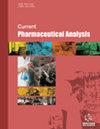Improved Detection of Veterinary Drug Residues: Advancing Analytical Techniques to Ensure Food Safety
IF 1.5
4区 医学
Q4 PHARMACOLOGY & PHARMACY
引用次数: 0
Abstract
: Veterinary drug residues in foods pose risks to consumers and promote antimicrobial resistance. Effective detection methods are needed to monitor and control residues. Recent advancements in analytical techniques for veterinary drug residue detection were reviewed. Key sample preparation methods, including QuEChERS, SPE, ASE, and LLE, were summarized. Instrumental analysis techniques including LC-MS/MS, GC-MS, immunoassays, CE and biosensors were examined. Recent trends and future directions were identified. LC-MS/MS and GC-MS provide the highest sensitivity and specificity for veterinary drug residue analysis. However, selectivity remains a challenge, particularly for complex matrices like meat and liver. Multi-residue methods now cover over 100 analytes, but analyzing new and legacy drugs lacking established methods is difficult. Increased sensitivity has been achieved through UHPLC and high resolution MS, but detection limits below 1 μg/kg often remain elusive. sSimplified on-site tests are gaining interest. More selective extraction strategies, data-driven multi-residue methods, microflow LC, and integrated analytical platforms may help address current challenges. Continued advances in sample preparation, instrumentation, data processing, and validation will be needed to fully realize the potential of veterinary drug residue detection and ensure food safety.改进兽药残留检测:推进分析技术以确保食品安全
:食品中的兽药残留会给消费者带来风险,并助长抗菌药耐药性。需要有效的检测方法来监测和控制残留。本文回顾了兽药残留检测分析技术的最新进展。总结了主要的样品制备方法,包括 QuEChERS、SPE、ASE 和 LLE。考察了包括 LC-MS/MS、GC-MS、免疫测定、CE 和生物传感器在内的仪器分析技术。确定了最新趋势和未来方向。LC-MS/MS 和 GC-MS 为兽药残留分析提供了最高的灵敏度和特异性。然而,选择性仍然是一项挑战,尤其是对于肉类和肝脏等复杂基质。多残留分析方法目前已涵盖 100 多种分析物,但要分析缺乏既定方法的新药和旧药仍很困难。通过超高效液相色谱法和高分辨率质谱法提高了灵敏度,但低于 1 μg/kg 的检测限仍然难以达到。选择性更强的萃取策略、数据驱动的多残留方法、微流液相色谱和集成分析平台可能有助于应对当前的挑战。要充分发挥兽药残留检测的潜力并确保食品安全,还需要在样品制备、仪器、数据处理和验证方面不断进步。
本文章由计算机程序翻译,如有差异,请以英文原文为准。
求助全文
约1分钟内获得全文
求助全文
来源期刊
CiteScore
1.50
自引率
0.00%
发文量
85
审稿时长
3 months
期刊介绍:
Aims & Scope
Current Pharmaceutical Analysis publishes expert reviews and original research articles on all the most recent advances in pharmaceutical and biomedical analysis. All aspects of the field are represented including drug analysis, analytical methodology and instrumentation. The journal is essential to all involved in pharmaceutical, biochemical and clinical analysis.

 求助内容:
求助内容: 应助结果提醒方式:
应助结果提醒方式:


